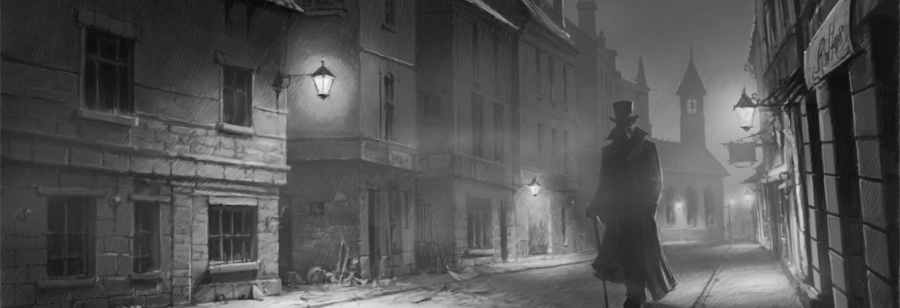
Jack the Ripper is a name that will forever be associated with the East End of London. It is a name that has both fascinated and confounded generations of police, the public, and Ripperologists. Even today, over a century since the gruesome East End murders took place, the public’s imagination with this elusive killer persists. Numerous TV programmes and Films featuring Jack the Ripper as their principal subject abound.
So what do we know about the subject? Countless Jack the Ripper books exist for the individual who wants to investigate this subject further, but an outline of the facts is laid out below.
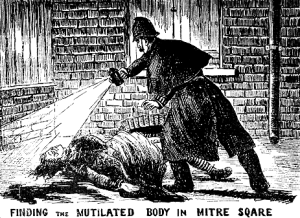 A series of murders took place in the dark and largely unlit streets of London’s East End and these were investigated with increasing urgency by Scotland Yard in the autumn of 1888. The victims were all women, and were linked by a common Modus Operandi – the gruesome disfigurement of their bodies by the murderer, who was never identified. The individual became known as Jack the Ripper principally because of a letter sent to Scotland Yard, apparently signed by the murderer. The identity of Jack the Ripper has been a mystery ever since. Whilst modern investigation techniques and forensic science have advanced since those days, it is still true that an apparently motiveless murder by a stranger committed in a public place out of the sight of witnesses is still difficult to solve today. There have been a number of attempts to clearly define those murders attributed to the Ripper, but the five listed below are accepted as being the work of one individual…
A series of murders took place in the dark and largely unlit streets of London’s East End and these were investigated with increasing urgency by Scotland Yard in the autumn of 1888. The victims were all women, and were linked by a common Modus Operandi – the gruesome disfigurement of their bodies by the murderer, who was never identified. The individual became known as Jack the Ripper principally because of a letter sent to Scotland Yard, apparently signed by the murderer. The identity of Jack the Ripper has been a mystery ever since. Whilst modern investigation techniques and forensic science have advanced since those days, it is still true that an apparently motiveless murder by a stranger committed in a public place out of the sight of witnesses is still difficult to solve today. There have been a number of attempts to clearly define those murders attributed to the Ripper, but the five listed below are accepted as being the work of one individual…
|
Friday 31 August 1888 |
Mary Ann Nichols |
Buck’s Row, Whitechapel, |
|
Saturday 8 September 1888 |
Annie Chapman |
Rear Yard at 29 Hanbury Street, Spitalfields. |
|
Sunday 30 September 1888 |
Elizabeth Stride |
Yard at side of 40 Berner Street, |
|
Sunday 30 September 1888 |
Catherine Eddowes |
Mitre Square, Aldgate, City of London. |
|
Friday 9 November 1888 |
Mary Jane Kelly |
13 Miller’s Court, |
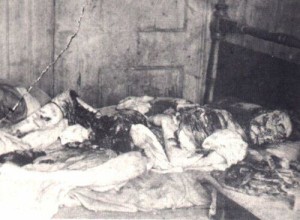
The murder of Mary Kelly, in November 1888, was accompanied by mutilation of such ferocity that it beggared description, and, for once, left the press short of words to adequately describe it – a poor quality grainy picture is all that modern Jack the Ripper investigators have to study – and the body is so badly mutilated, it is barely recognisable.
The Suspects
Because of the way in which the victims’ bodies were mutilated with a sharp knife or scalpel, some medical knowledge or skill at wielding a knife (for example, as a butcher) rapidly became one of the principal criteria for suspicion. The four main suspects can be listed as:
Aaron Kosminski – a poor Polish Jew resident in Whitechapel;
Montague John Druitt- a 31 year old barrister and school teacher who committed suicide in December 1888
Michael Ostrog, a Russian-born thief and confidence trickster (he went by many aliases) who was believed to be 55 years old in 1888, and who had been detained in asylums on several occasions
Dr Francis J. Tumblety – a 56 year old American ‘quack’ doctor, who was arrested in November 1888 for offences of gross indecency, and fled the country later the same month.
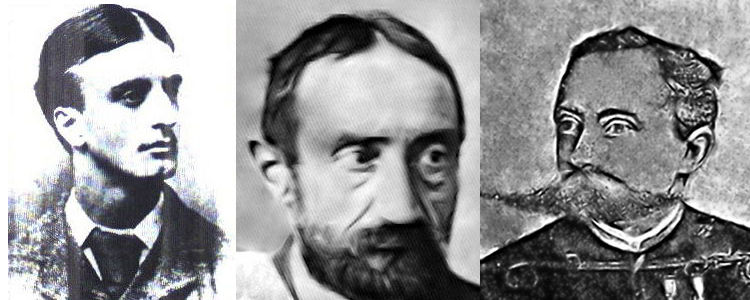
Druitt, Ostrog and Tumblety
So – why ‘Jack the Ripper?
The name that we have been left with for these crimes, ‘Jack the Ripper’ is easy to explain. It was written at the end of a letter dated 25 September, 1888 and sent to the Central News Agency on 27 September, 1888. The agency – having had it in their possession for two days, forwarded it to the Metropolitan Police on 29 September.
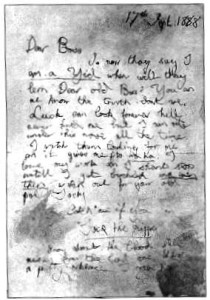
The letter was written in a florid, loose script and began “Dear Boss……” It went on to talk of “That joke about Leather Apron gave me real fits……” (The name ‘Leather Apron’ was attributed to a John Pizer, briefly suspected at the time of the Chapman murder). “I am down on whores and I shan’t quit ripping them till I do get buckled…” and so on in a similar vein. The signature at the end of the letter, ‘Jack the Ripper’, was then made public fuelling the agitation and hysteria that had now gripped the East End.
The dual murders that subsequently took place on the 30 September 1888 gave the letter even greater importance and as if to underline it, the unknown writer once again committed red ink to a postcard sent on 1 October. In this communication he referred to himself as ‘Saucy Jacky…‘ and spoke of the “double event…….” He again signed off as Jack the Ripper….
